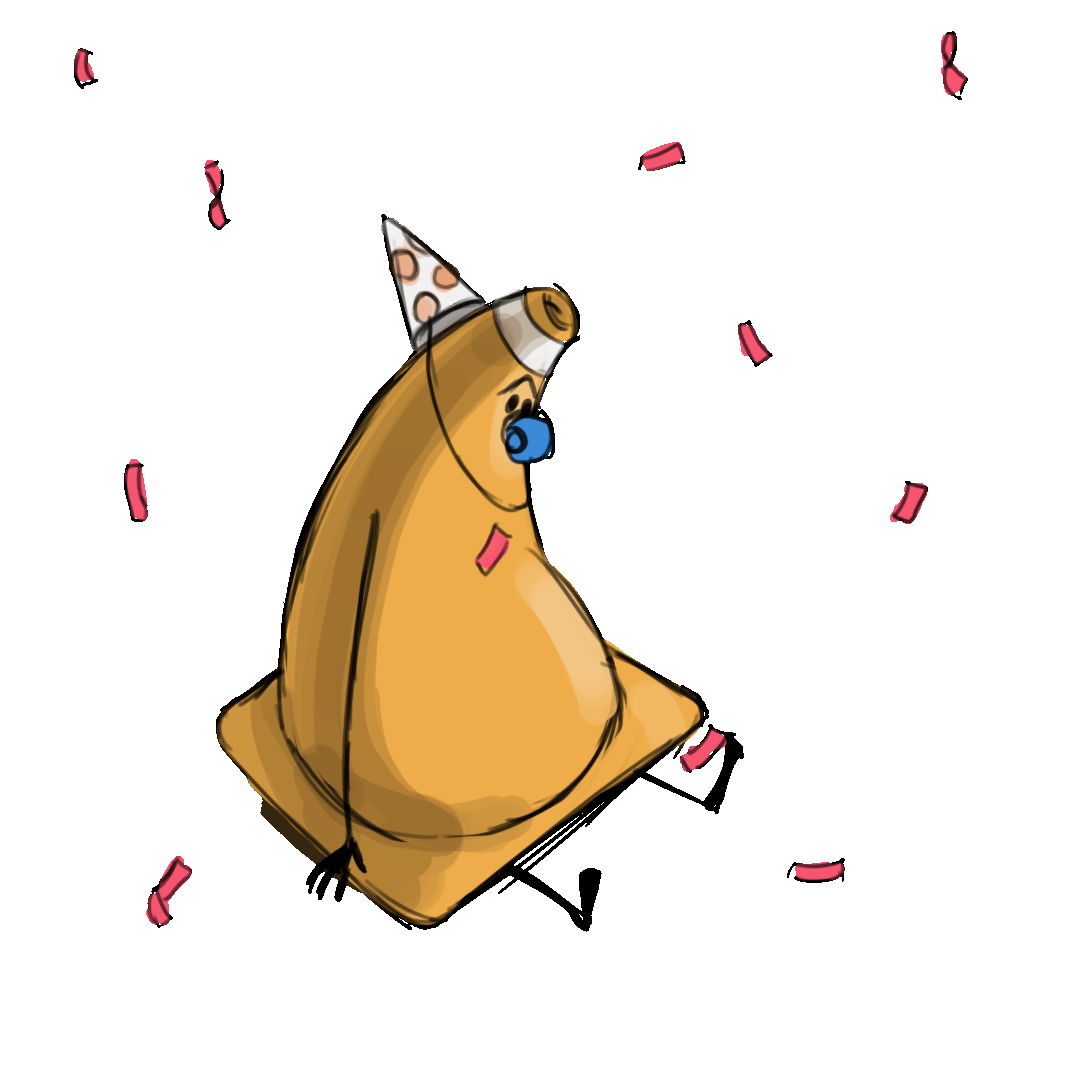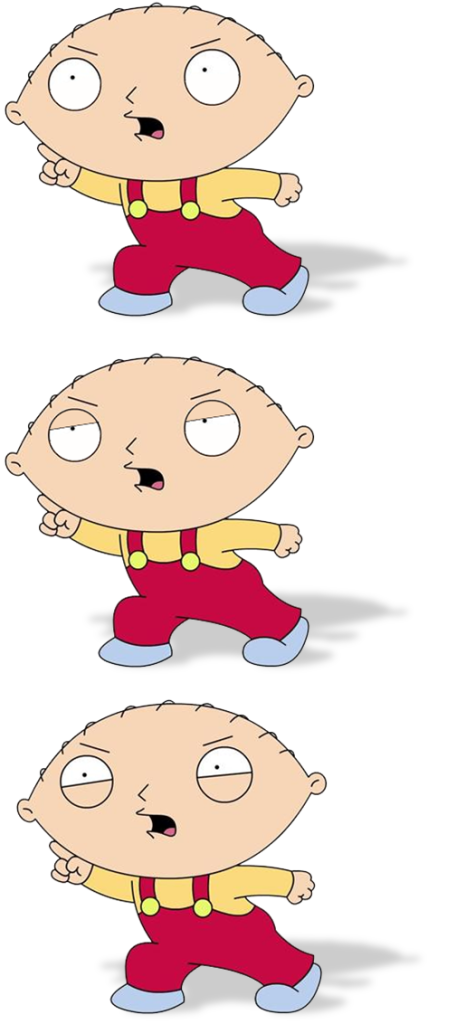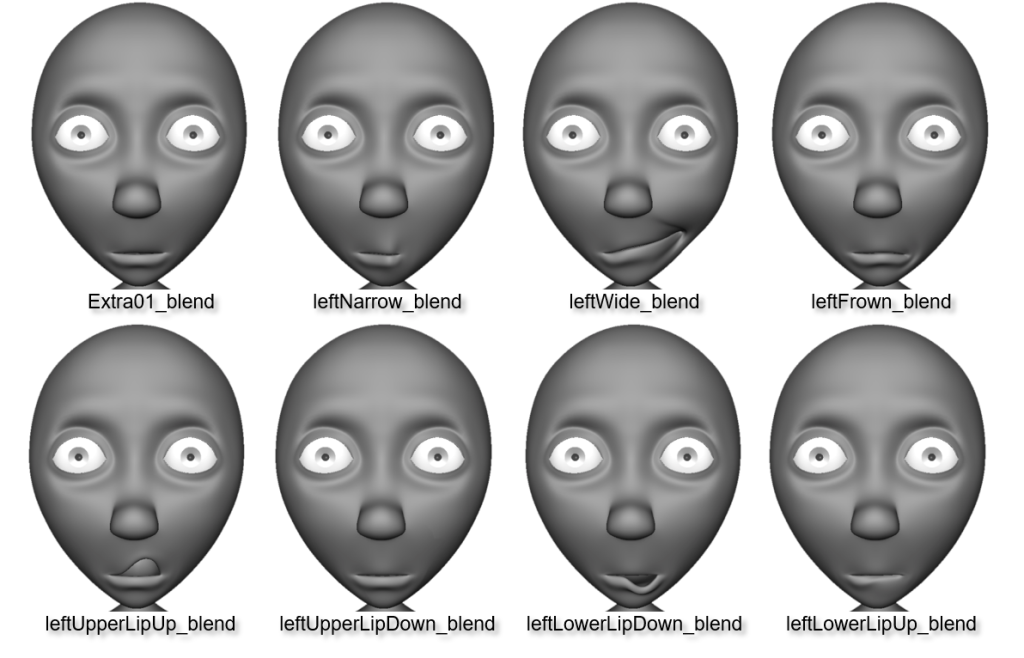3D Character Creation
Class 15: Rig & AnimationTopics
- Character Perfomance
- Face Design
- Lip-Sync
- Rig & Animation Project

Last class….hurray….
Character Performance
Acting for Animation vs. Live-Action:
- Actors feel implicitly and it expresses explicitly. Animators control the external to make it appear it comes from the internal.
- Live-action may be more spontaneous while animation is planned. Actors may ad-lib a line while animators must animate to a line exactly.
- Live-action acting is more subtle, natural, and realistic. Animation acting is large, iconic, and similar to stage performances like dance.
Choices:
When you first start animating you struggle with the process, the medium, and whatever software package you are using. Once you have a grip on that and you feel comfortable employing the principles of animation effectively it is all about choices. You must make acting choices that are easily read, novel, and have appeal
Good Acting (choices):
-
- Readable
- Obviously your viewer should be able to read what is happening on screen and your character must be able to communicate.
-
- Convincing
- This is a difficult thing to do in animation. You must make your character to appear to have an internal motivation externally.
-
- Appealing
- Animation is art. Part of this means that your acting choices must be visually interesting.
-
- Novel
- Although animated performances are exaggerated it is still paramount to avoid cliches. You want to produce unique innovative poses.
Acting Beat:
An acting beat is a small amount of time, 1/2 second, that equates to one thought. It is important to allow poses to breath. This produces a strong beat that mimics internal thought and also allows the audience time to read the pose.
at 1:30 you can see Golemn pause to show internal thought
Vocal Track:
If you work in film animation, 90% of your work will involve dialogue. This is both a blessing and a curse. It limits what you can do but it also really helps drive your performance.
Reference:
The best way to produce a strong novel performance is to act out your scenes yourself. A reference video will give you:
-
- Mechanics
- It is much easier to apply body mechanics to a character if you can see the real thing in front of you.
-
- Improvisation
- Everything in animation is very well planned out since by nature it is so methodical. If you act out your actions you have the opportunity to be spontaneous.
-
- Nuance
- It is very easy to miss some of the smaller motions that break up larger ones. A good example of nuance is watching someone sit down. You will notice that they don’t simply just sit down they will readjust.
-
- Novel
- Typically the first thought that pops into your head is the most generic cliched version. Your performance is more likely to be innovative if you actually perform it.
Face Design
Expression:
It is the character emotion that sucks the audience in and allows the story to progress. For this reason getting the character expression right is extremely important.
Expression Process/Meaning:
Like all processes it is best to work broad to specific.
- Body
- Work the entire body first. This is what the audience reads first. You can tell a lot by the body language of the character.
- Head
- The head tilt can actually say a lot all by itself. It also affects how all the other facial features are perceived.
-
- Forward
- External, direct usually angry
- Backward
- Internal (can be sad, angry, scared, etc.)
- Sideways
- Inquisitive
- Mouth & Nose
- Although brows are more expressive you can get more subtle and less cliche emotion using the mouth.
- If possible look for asymmetry in mouth poses. Mouths do not actually move all that symmetrical.
- Eyelids & Cheeks
- Generally eyelids portray alertness and the intensity of emotion. They are probably the strongest indicator of emotion while also have the ability to be the most subtle.
-
- Upper Lids
- When closed appears drowsy, bored, un-alert.
- When open appears awake, startled, alert.
- Lower Lids
- When open appears awake, not intense.
- When closed appears more intense.
- Cheeks
- When squinting helps intensify the emotion.
- This is the difference between a real smile and a fake one.
- Brows
- These should be completed last. You are far more likely to produce a cliche pose using the eyebrows. They should be used as a fail-safe if you can’t produce the emotion you are looking for.
-
- Up & Down
- These are pretty obvious. Up may be happy, sad, frightened, etc. Down is typically angry, stubborn, thinking, etc.
- Squeeze
- Like the lower eyelids this helps intensify an emotion.

Lip-Sync
Phonemes:
When animating lip-sync, traditional hand-drawn & stop-motion animation, most often employs the use of phonemes. Phonemes are the mouth positions associated with the different sounds of human speech. You will notice watching any Saturday morning or Sunday night animated show that the characters have distinct mouth drawings for each sound.
Visimes:
Visimes are similar to phonemes except they are not tied to specific mouth shapes for specific sounds & text but rather just thinks about the actual lip position at a specific time. Visimes use a combination of shapes to illustrate sound. It is easier to breakdown dialogue in CG this way.
 |
 |
 |
 |
| Closed | AH | EE | OO |
 |
 |
 |
 |
| AR | EL/TH | F | MM |
Lip-Sync Process:
- Primary Targets
-
- Jaw Open/Shut
- You can look at this as a volume controller
- This is the most important target. It is similar to using a sock puppet.
- Wide/Narrow
- Generally speaking this controls the pitch of the sound.
- At its widest mouth makes an EE sound. At its most narrow you get OO.
- Secondary Targets
-
- Lips Up/Down
- The combination of moving upper & lower lips helps give stronger consonants and vowels such as FF, BB, AR, etc.
- Special Cases
- There are a number of less used shapes that are necessary to support certain sounds and express emotion
-
- Tertiary Shapes
- Frown
- Pucker/Purse
- Lips Left/Right
- Sneer
- Etc.

Rig & Animation Project
Rig & Animation Project
Using one of the models from a previous project students will rig, motion-capture, and animate a small sequence. A simple choreographed sequence like dancing, acrobatics, llocomotion, etc. is suggested. The final sequence should be appropriate to implement into a game, film, or other media.
You will be graded on the following:
- Skeleton:
- Skeleton placement take cues from anatomy and the model itself. Joints are bound to the model resulting in proper deformation.
- Rigging:
- Well executed motion capture. Errors have been fixed. Motion has been smoothed.
- Animation:
- Animation of the character has strong poses, snappy movement, and is exceptionally clear.
- Lipsync:
- Appropriate and expressive facial blend shapes produced. Facial keys accurately represent the audio.
Resources:
- Assignment Video Tutorials
- You may watch the tutorial videos below to help you complete your assignment.
Assignment Video Tutorials
Wait! Before you go!
Did you remember to?
- Read through this webpage
- Submit Rig & Animation Project on Blackboard

